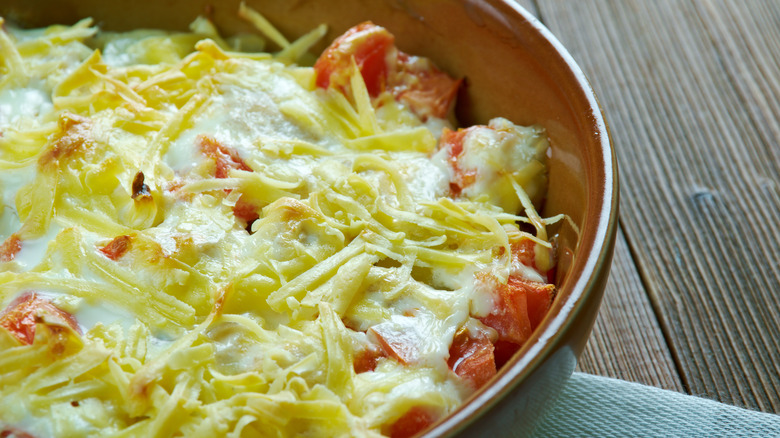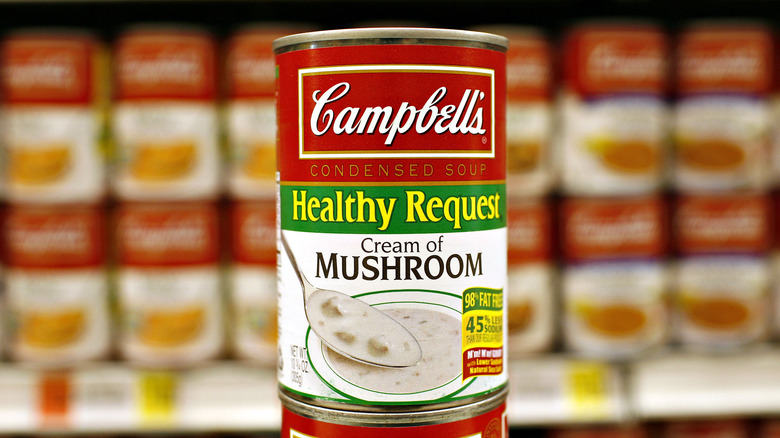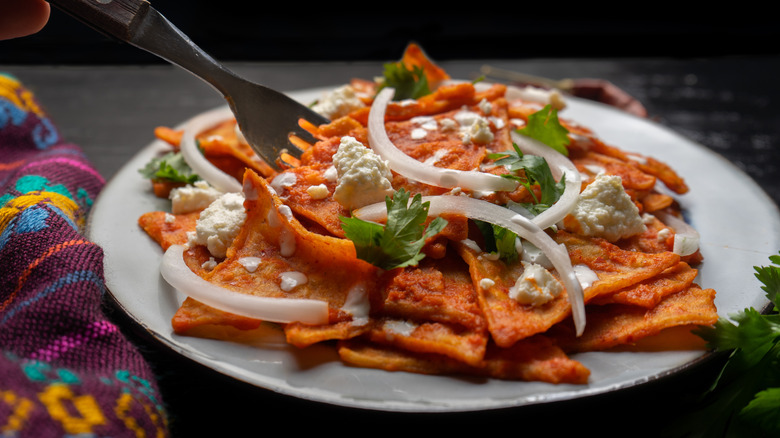The Murky Texas Origins Of King Ranch Chicken Casserole
Casseroles are the epitome of down-home comfort food, calling to mind casual family dinners and cozy BYO party spreads. Economical and delicious, a casserole proves that little more than a can of condensed soup can unlock the potential of your lackluster leftovers. According to Google Trends, America's interest in casserole recipes peaks in November, right before the big comfort food feast that is Thanksgiving.
Each state and region has its casserole preference. Eater notes that Minnesota has a penchant for the meat-and-potato-packed hot dish, and Salt Lake Magazine admits that the glumly titled "funeral potatoes," a cheesy hash-brown casserole, is a signature part of Utah's culinary identity. If you're a Texan native, you're most likely familiar with one casserole that reigns above all others: the King Ranch chicken casserole.
The star of the Texan potluck — alongside anything else made with Ro-tel — King Ranch chicken casserole is layered with chicken, tortillas, chiles, tomatoes, condensed soup, cheese, and plenty of mystery (via Southern Living). What can be mysterious about a casserole? Quite a bit, actually.
Canned convenience and community cookbooks
The ingredients featured in the recipe help date its creation. Following World War II, canned goods and processed food became an affordable luxury for home cooks, cutting down on prep time in the kitchen (via National Woman's History Museum). One such favorite canned good was condensed soup, an ingredient that mimicked the tasty qualities of a homemade roux and launched a thousand casseroles. Containing cans of cream of mushroom soup or cream of chicken soup, Texas Monthly claims King Ranch chicken casserole is a product of the 1950s, fully embracing the convenience of processed food.
Texas Monthly notes the recipe spread like wildfire, making its rounds in numerous community cookbooks from Dallas to El Paso. (Think of it as the retro version of going viral.) But who was behind this popular recipe? The title seemed to call out King Ranch, the largest ranch in Texas and a state institution since 1853, per Houstonia.
Still, King Ranch, which size-wise eclipses the state of Rhode Island, is overrun with cattle, not chickens. Imagine millions of chickens hot-footing it away from cowboys on a ranch of 1,289 square miles. It's just impractical. According to Houstonia, the estate and its chefs have never claimed it as their own. So why did the King Ranch name get tacked onto a famous chicken casserole? Texas Monthly suggests a blend of brand recognition and marketing. In a sea of casseroles, the King Ranch chicken casserole would be known as a comforting dish without any sophistication.
Inspiration from south of the border
The influence of Mexican cuisine on Texas is evident, and the King Ranch casserole is no exception. Texas Monthly looks to the classic Mexican breakfast dish, chilaquiles, as the original inspiration. To make chilaquiles, stale tortillas or tortilla chips are simmered in salsa before being topped with chicken, cheese, eggs, or whatever else the chef desires. Much like a casserole, this dish uses leftovers to create a new and flavorful dish. Beyond using chilaquiles as a recipe blueprint, home cooks used plenty of aromatic Hispanic ingredients to elevate the flavor, like chiles and tomatoes.
Lisa Fain of the Homesick Texan posits another theory. Lisa draws a thread between King Ranch chicken and Chicken a la King, a chicken, mushroom, cream, and toast dish. She wonders if an enterprising Texan combined the Chicken a la King with their Tex-Mex sensibilities, incorporating Ro-tel and corn tortillas to up the game. Still, nothing can be definitively proven. The true origin of King Ranch chicken will remain a murky, albeit tasty, mystery.


